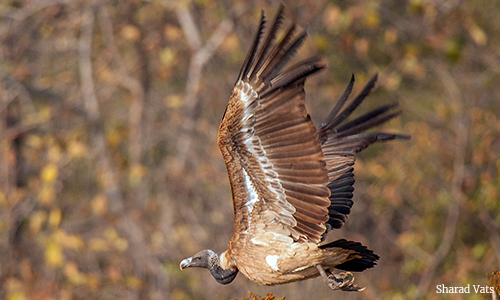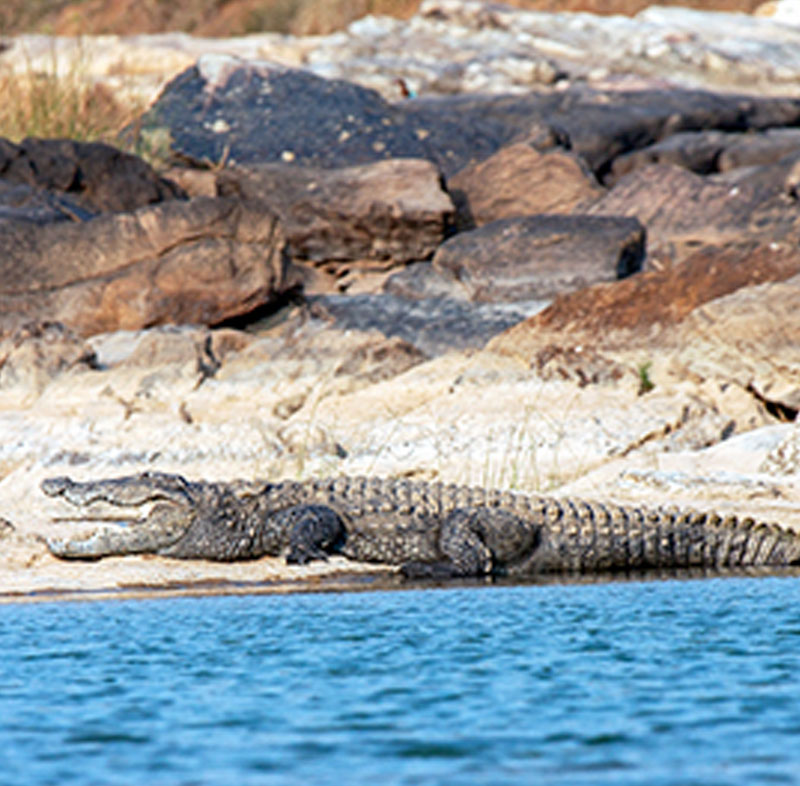Panna is a small, but stunningly beautiful park. Deep ravines and cliff faces, topped by rocky plateaus, are augmented by greenery and a series of gorgeous waterfalls that flow down into the Ken River below. Panna’s biodiversity is rather remarkable, as it’s situated at the juncture of the northernmost natural teak forests and the easternmost tip of the natural kardhai forests. Short dry grasslands let out onto open woodlands. The rocky terrain is interspersed with thick vegetation including Teak, Acacia, as well as the sweet scented Mahua and the fiery blossoms of the Flame of the Forest.
The Ken river is the region’s perennial lifeline, and these forests form a large part of its catchment area. It also means that the riverbanks attract over 300 species of birds and is one of the few natural habitats of the Gharial (the long snouted crocodile) and the Muggar (the marsh crocodile) which are often seen basking along its banks. Panna also has a sizable number of felines including a few tigers and several leopards. The tigers went extinct thanks to extensive poaching, but have recently made a come back thanks to major conservation efforts that were made in a timely manner.

Panna is the northernmost park in Madhya Pradesh and is situated in the Panna and Chattarpur districts, 40 kilometers east of Khajuraho.

Topography: Panna has an unusual topography. It is situated right where the southern dry deciduous forests that start all the way at Cape Cormorin end, and the moist deciduous forests of the Upper Gangetic Plains begins. Natural teak forests halt their journey north, and the kardhai forests halt their journey east once they reach Panna. The craggy cliffs and gorges are topped by rocky plateaus and give way to the Ken River valley below.
In Season: The park is open from…
Panna’s tiger conservation project is an ongoing initiative, which is supported by private, public, local and international organizations on a large scale. When all the tigers were poached to death in 2009, a male tiger was relocated from Pench, in the hope that it would mate with two females that were brought in from Bandhavgarh. The tiger, however, had a strong homing instinct and began to walk its way through forests and villages, back towards its home range in Pench – remarkably without harming a single human being. After tracking the animal for a month, the forest officials took him back to Panna, where he settled in comfortably the second time and mated with both females to give birth to cubs, which constitute the current tiger population in Pench.
Panna’s deep ravines and craggy cliffs are ideal territory for leopards and you’ll find several of these magnificent felines among the rocky terrain and in the treetops. The tiger population in Panna is making a steady comeback and their numbers are increasing with each mating season. The park is also home to sloth bears though they remain well hidden among the tree cover.
The other major predators here, which are prolific, are the Gharial and Mugger crocodiles. One can see several of these creatures in the neighboring Ken Gharial Wildlife Sanctuary. They lie perfectly camouflaged on the banks of the river, or on rocky outcrops, waiting for an unsuspecting victim to fall prey to their stealth and the strength of their jaws. Panna is also the perfect environment for raptors. Eagles, buzzards and vultures are often seeing skimming the thermals and darting through the ravines in search of carrion and prey.
Panna has several species of deer including the Cheetal (Spotted Deer) and the Sambhar. The Chinkara (Indian gazelle) and Nilgai (The Blue Bull Antelope) are also commonly found here. Several monkeys and smaller herbivores are also commonly found here. In fact the park is filled with the hoots of the Langur, the black-faced monkey, and it’s also home to quite a few reptiles, including several snakes.
Panna is home to over 200 species of birds – both resident and migratory. Some of these include the Bar-headed Goose, storks, paradise fly-catchers and hornbills, just to name a few. Babblers, warblers, shrikes and teals are easily seen. The Ken river is home to several different species of duck and geese as well as water birds such as the cormorant. Birds of prey such as falcons, vultures, eagles and owls call Panna’s forests their home. While vultures are slowly dying out across the entire subcontinent, there are still a few pockets such as the Bandhavgah Kymore hills and Panna, where the population continues to flourish. Panna is particularly known for its white-back and long-billed vultures.
The nearest airport is at:
The nearest railway stations are at:

Game drives by jeep – the forest department does not have their own vehicles in Panna, so your game drive is operated by your lodge.

Boat safaris – take a boat ride down the Ken river and watch the crocodiles and several species of water birds. Several animals also come down to the river for a drink.

Pandav Falls – Situated along a tributary of the Ken river, legend states that the five Pandav brothers from the epic Maharabharata, visited here.

Rajgarh Fort – An ancient fortress that overlooks the Panna region.

Raneh Falls – A series of waterfalls that run through a long canyon that is carved out of granite, in different hues, ranging from pink and red to grey.

Kalinjar Fort – Kalinjar fort is strategically located on a rocky outcrop about 180 km from Panna. It served several rulers and historians date the temples and palaces within it back to the Gupta dynasty of 3 AD.


Khajuraho Temples – The Khajuraho group of temples are a globally renown UNESCO World Heritage Site. These ancient Jain and Hindu temples are several centuries old and are particularly known for their erotic carved sculptures that are based on philosophy of the Kamasutra.
The best times to visit Panna are from November to March.
Panna experiences extremes of temperature. Winters can be very cold and chilly before the sun comes up and after it goes down. The night temperatures can easily be as low as zero degrees centigrade in the winter months. Summers are very hot and very dry.
Pashangarh –
A Taj Safaris Lodge: What we love…the enormous sense of space. Pashangarh has just twelve stone villas located across almost 200 acres of land. You can enjoy a nature walk or bike ride on the property itself!
The Sarai at Toria :
What we love… The Sarai at Toria is owned and run by one of India’s top tiger conservationists, who also happens to be a culinary enthusiast! Enjoy delicious meals of ethnic cuisine while listening to terrific tales about tigers!
Ken River Lodge :
What we love… The focal point of this charming boutique hideaway is the enormous tree-house in two huge fig trees that span the Ken River. Enjoy your meals or simply relax in this gorgeous treetop hideaway.
Camp Panna :
What we love…Mud roofs and traditional wooden doors give it a delightful ethnic touch.
If you’re looking for a blend of culture and nature, Panna is the perfect place to visit. Beyond the national park, Panna is the perfect jumping off spot from which to visit ancient temples, fortresses and tribal settlements. The range of activities and easy accessibility from Khajuraho also makes it a fun, exciting and educational opportunity for families traveling with younger children.
Panna faces a huge challenge at the moment. In order to address acute drought in the region, the government of India proposes to link the Ken and Betwa rivers to one another. Ecological estimates believe that close to a third of the park will be submerged as a result of the backwaters from the increased height of existing dams on the Ken river that have been proposed. Currently several experts are weighing in on both sides, and the fate of this biosphere hangs in the balance.